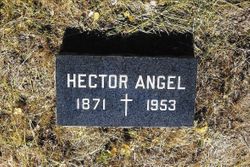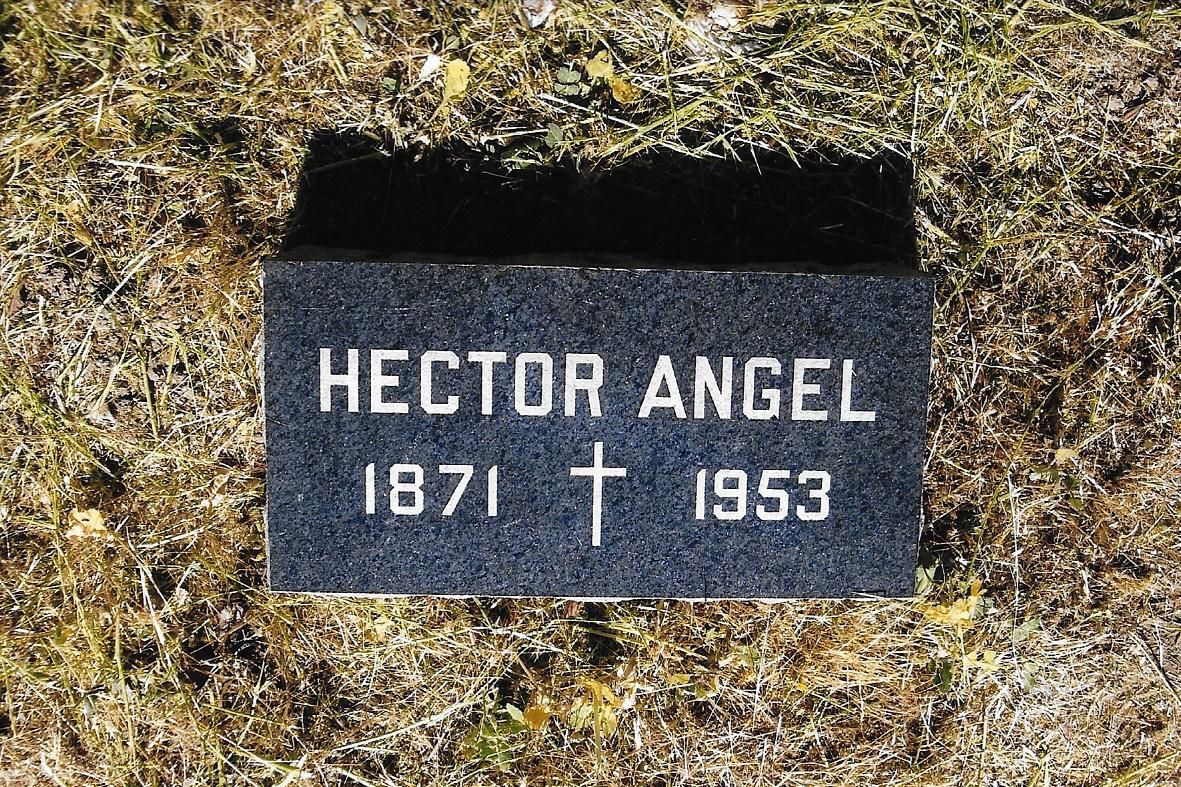__________________________________________________
The Angels of Mesa Grande
By Darrell Beck - Ramona Home Journal•Thu, Jun 18, 2015
James Newton Angel (1841-1934) of Jasper County, Mo., was six years old when his parents, Woodson and Jane (Stites) Angel, decided to leave the cold winters of Missouri and go westward, seeking new land and a better climate.
On April 14, 1847, the Angel family left Independence, Mo., in a wagon train of 90 wagons bound for Oregon, led by Newton’s grandfather John Stites acting as wagon master. Each wagon was pulled by four oxen, and the wagon train was accompanied by large herds of loose stock, including Angel’s Hereford cattle and Kentucky horses.
Along the trail in Nebraska, a young girl died of measles and was buried on the prairie in a box made of boards taken from the sides of a wagon. Later, as the wagon train was crossing the Rocky Mountains, Angel’s two lead oxen were stolen by Indians during the night. On the following day, some of the men armed themselves and followed their trail, only to find the oxen had been butchered and the meat was laid out on rocks, drying. They never found the Indians. As there were no more oxen, Woodson hitched up two cows and was able to quickly break them to the yoke. They became a good team, taking the family safely to their destination.
Somewhere along the trail, the train split, with some wagons going to Oregon, and the others carrying on to California. The Angel party took the same route over the Sierra Nevada the fateful Donner party had taken the previous year just north of Lake Tahoe, but because they had traveled during the spring, rather than winter, the Angel party was not stranded in heavy snow. Nevertheless, when the wagon train encountered a steep incline on the trail, it was necessary to cut some poles and remove the wheels from the wagons so they could be lowered with ropes. Once the wagons were on level ground, they were reassembled and the journey resumed.
There were few people in California in 1847, so the Angel family first came to Fort Stockton but later settled in San Jose, which was only a small Mexican village of about 40 adobe homes. There, the family took up farming and raised livestock.
When Newton Angel was 24, he became sheriff of Gilroy. One time, he was called out in an attempt to capture the Mexican marauder Tiburico Vasquez, but the outlaw escaped.
In 1868, Newton married 15-year-old Henrietta Haun. During the following dozen years, the Angel family moved from Central California to Texas and then to Oregon. In February of 1880, the family came to Mesa Grande. They bought the 160-acre ranch of Walter O’Brien, located near the 4,555-foot peak that became known as Angel Mountain, named in their honor.
Shortly after the Newton Angel family settled in Mesa Grande, his aging father, Woodson, and brother, John Angel, came to stay at the ranch.
The O’Brien homestead was located in a lush valley with plenty of water and timber. The family lived from the land, just as did most of the pioneers, and engaged in general ranching and cattle for many years.
After "proving up” the O’Brien homestead, the Angels eventually expanded their land holdings to more than 2,500 acres, including the John Minter Ranch, on which the only encounter of the Civil War had taken place in California, when Major Edwin A. Rigg, commander of Camp Wright in Oak Grove, captured 18 armed Confederate sympathizers.
Newton and Henrietta Angel raised 11 children: Mary Ellen, Colonel Hector "Hec,” Vance V., Mandeville Verde, Marcus L., Fredrick M. "Fred,” Fannie H. (who married Herb Hill), Philip G. "Phil,” Henry Newton "Newt,” Lester Amadon "Jack,” and Jessie Royal "Roy.”
"Roy recalls that the Angels never had a physician in the house,” historian and columnist Eloise Perkins wrote in 1968. "His father had studied medicine with a doctor and assisted him even in operations. Later, Angel performed the services of a physician at the births of all 11 children born to his wife.”
Pioneer, historian and editor James Jasper said in "Trail Breakers and History Makers” about Angel: "Of strong religious convictions, both he and his wife for years were identified with the Christian Church and gave strong support to missionary and charitable institutions. They were firm supporters of educational institutions, and Mr. Angel served for many years as school trustee of Mesa Grande School District. They were honorable citizens, and a valuable asset to the community.”
The Angel family certainly left an imposing and historic impression on Mesa Grande, the backcountry and the surrounding region. Today, there are many descendants still living in the area.
~ source: Ramona Journal
http://ramonajournal.com/the-angels-of-mesa-grande-p6973-275.htm
__________________________-
~ Colonel was Mr. Angel's given first name and not a military rank.
Contributor: Sharon Bartholomew (48448658)
__________________________________________________
The Angels of Mesa Grande
By Darrell Beck - Ramona Home Journal•Thu, Jun 18, 2015
James Newton Angel (1841-1934) of Jasper County, Mo., was six years old when his parents, Woodson and Jane (Stites) Angel, decided to leave the cold winters of Missouri and go westward, seeking new land and a better climate.
On April 14, 1847, the Angel family left Independence, Mo., in a wagon train of 90 wagons bound for Oregon, led by Newton’s grandfather John Stites acting as wagon master. Each wagon was pulled by four oxen, and the wagon train was accompanied by large herds of loose stock, including Angel’s Hereford cattle and Kentucky horses.
Along the trail in Nebraska, a young girl died of measles and was buried on the prairie in a box made of boards taken from the sides of a wagon. Later, as the wagon train was crossing the Rocky Mountains, Angel’s two lead oxen were stolen by Indians during the night. On the following day, some of the men armed themselves and followed their trail, only to find the oxen had been butchered and the meat was laid out on rocks, drying. They never found the Indians. As there were no more oxen, Woodson hitched up two cows and was able to quickly break them to the yoke. They became a good team, taking the family safely to their destination.
Somewhere along the trail, the train split, with some wagons going to Oregon, and the others carrying on to California. The Angel party took the same route over the Sierra Nevada the fateful Donner party had taken the previous year just north of Lake Tahoe, but because they had traveled during the spring, rather than winter, the Angel party was not stranded in heavy snow. Nevertheless, when the wagon train encountered a steep incline on the trail, it was necessary to cut some poles and remove the wheels from the wagons so they could be lowered with ropes. Once the wagons were on level ground, they were reassembled and the journey resumed.
There were few people in California in 1847, so the Angel family first came to Fort Stockton but later settled in San Jose, which was only a small Mexican village of about 40 adobe homes. There, the family took up farming and raised livestock.
When Newton Angel was 24, he became sheriff of Gilroy. One time, he was called out in an attempt to capture the Mexican marauder Tiburico Vasquez, but the outlaw escaped.
In 1868, Newton married 15-year-old Henrietta Haun. During the following dozen years, the Angel family moved from Central California to Texas and then to Oregon. In February of 1880, the family came to Mesa Grande. They bought the 160-acre ranch of Walter O’Brien, located near the 4,555-foot peak that became known as Angel Mountain, named in their honor.
Shortly after the Newton Angel family settled in Mesa Grande, his aging father, Woodson, and brother, John Angel, came to stay at the ranch.
The O’Brien homestead was located in a lush valley with plenty of water and timber. The family lived from the land, just as did most of the pioneers, and engaged in general ranching and cattle for many years.
After "proving up” the O’Brien homestead, the Angels eventually expanded their land holdings to more than 2,500 acres, including the John Minter Ranch, on which the only encounter of the Civil War had taken place in California, when Major Edwin A. Rigg, commander of Camp Wright in Oak Grove, captured 18 armed Confederate sympathizers.
Newton and Henrietta Angel raised 11 children: Mary Ellen, Colonel Hector "Hec,” Vance V., Mandeville Verde, Marcus L., Fredrick M. "Fred,” Fannie H. (who married Herb Hill), Philip G. "Phil,” Henry Newton "Newt,” Lester Amadon "Jack,” and Jessie Royal "Roy.”
"Roy recalls that the Angels never had a physician in the house,” historian and columnist Eloise Perkins wrote in 1968. "His father had studied medicine with a doctor and assisted him even in operations. Later, Angel performed the services of a physician at the births of all 11 children born to his wife.”
Pioneer, historian and editor James Jasper said in "Trail Breakers and History Makers” about Angel: "Of strong religious convictions, both he and his wife for years were identified with the Christian Church and gave strong support to missionary and charitable institutions. They were firm supporters of educational institutions, and Mr. Angel served for many years as school trustee of Mesa Grande School District. They were honorable citizens, and a valuable asset to the community.”
The Angel family certainly left an imposing and historic impression on Mesa Grande, the backcountry and the surrounding region. Today, there are many descendants still living in the area.
~ source: Ramona Journal
http://ramonajournal.com/the-angels-of-mesa-grande-p6973-275.htm
__________________________-
~ Colonel was Mr. Angel's given first name and not a military rank.
Contributor: Sharon Bartholomew (48448658)
Family Members
-
![]()
Mary Ellen "Mollie" Angel Pringle
1869–1954
-
![]()
Vance Victor Angel
1873–1967
-
![]()
Mandeville Verde Angel
1876–1951
-
![]()
Marcus P "Mark" Angel
1879–1891
-
![]()
Frederick M "Fred" Angel
1881–1968
-
![]()
Fannie Hester Angel Hill
1884–1924
-
![]()
Philip Grover Angel
1887–1977
-
![]()
Henry Newton Angel
1889–1955
-
![]()
Lester Amadon "Jack" Angel
1892–1980
-
![]()
Jesse Royal Angel
1894–1988
Sponsored by Ancestry
Advertisement
Explore more
Sponsored by Ancestry
Advertisement














